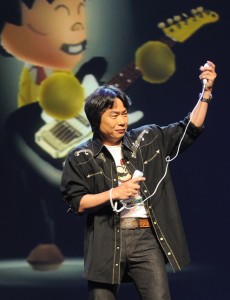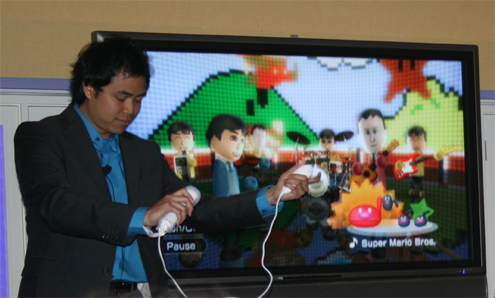“We have this firm belief that the more you chew, the more flavor you get.” Nintendo Representative JC Rodrigo told me at Nintendo’s Fall Media event in early October, “There’s a lot of different levels and depth to a game. Take Wii Music for example, Kids can pick it up and get the instant gratification of ”˜Oh, I get it, It’s a piano,’ but for guys that are really into music, it’s about arranging ridiculous stuff.” For some Nintendo fans, ridiculous is indeed the word that comes to mind. Since it’s introduction at E3 earlier this year, Wii Music has been criticized for being too simple, too limiting, and for not being a game. I didn’t know what to think, but I wanted to give the enthusiastic JC Rodrigo a chance to show me what Wii Music was all about.
“You have pitch bends, different ways to augment sounds, there’s a lot of different levels the game can be taken, but you have to be into it, you have to actually want to search them out. They’ll be there for you, but you have to seek them out and it’s only going to be the hardcore guys who will reach that far. The more you chew, the more you get.”
JC continued to emphasize that Wii Music was like a book that shouldn’t be judged by it’s cover, Wii Music was more than a simple toy. Picking up the controller, I was a little uncertain exactly how to play. Shaking the remote and pressing buttons simply made noise, JC told me “to make music, you have to have an Idea.” Taking up the controller, JC moved his virtual violin bow with the familiar beat of “Super Mario Bros,” causing the familiar song to flow from the TV. Gameplay is based on tempo, simply shaking the controller wont do, you need to move with the beat. Altering his beat, he showed me that you could coax the game into creating flourishes and alternative notes, telling me Wii Music could do more if you were “…into what Wii Music’s about, which is being creative.”
 If Wii Music is about being creative, it begs the question: can one really be creative with Wii Music? One of the most common complaints about Wii Music is that you can’t fail. The game is programmed to make everything “sound good,” if you can’t play a bad note, can you really be creative? Maybe. JC told me how Wii Music decides what notes are used to “fill in” your improvisation. He told me to imagine four or five parallel lines, representing possible notes. Imagine one line is darker than the others, the dark line is how the song is traditionally played while the other lines represent possible deviations. When the player adds an extra note, the game will choose from one of the non-darkened lines to decide what to play. This “new note” can be any note within the same musical key as the notes preceding and following the improvised one. When I heard this, something clicked in my head – Wii Music is like a Harmonica.  Anybody with an idea can play a harmonica and sound “okay,” not so much because it’s an easy instrument to play, but because every note on a harmonica is in they same key. This means every note on the instrument sounds “good” next to any other note on the instrument. The big difference between Wii Music and the Harmonica is that Wii Music chooses that same-key note for you, whereas the harmonica still leaves the choice to the player – it’s this distinction that keeps Wii Music grounded in toyland when it could be a musical tool, or even an instrument in its own right.
If Wii Music is about being creative, it begs the question: can one really be creative with Wii Music? One of the most common complaints about Wii Music is that you can’t fail. The game is programmed to make everything “sound good,” if you can’t play a bad note, can you really be creative? Maybe. JC told me how Wii Music decides what notes are used to “fill in” your improvisation. He told me to imagine four or five parallel lines, representing possible notes. Imagine one line is darker than the others, the dark line is how the song is traditionally played while the other lines represent possible deviations. When the player adds an extra note, the game will choose from one of the non-darkened lines to decide what to play. This “new note” can be any note within the same musical key as the notes preceding and following the improvised one. When I heard this, something clicked in my head – Wii Music is like a Harmonica.  Anybody with an idea can play a harmonica and sound “okay,” not so much because it’s an easy instrument to play, but because every note on a harmonica is in they same key. This means every note on the instrument sounds “good” next to any other note on the instrument. The big difference between Wii Music and the Harmonica is that Wii Music chooses that same-key note for you, whereas the harmonica still leaves the choice to the player – it’s this distinction that keeps Wii Music grounded in toyland when it could be a musical tool, or even an instrument in its own right.
Hearing JC describe how Wii Music worked validated the game’s musical theory for me, but the game seemed one feature short of a home run. Walking the line between playing an instrument and composing a song, Wii Music failed to go all the way on the latter – a song composition mode akin to what can be found in Mario Paint would have given Wii Music infinite replay value. Despite the fun idea of arranging new versions of familiar songs by mixing notes and changing instruments, the player is limited to the songs that come on the disc. I expressed my concerns to JC. “I really wanted that to happen, where you can get to a deeper level where you can actually pick out a note, but at that point ”¦you might as well just play a real instrument!” he said.
Still concerned, I pushed the issue a little further, and JC explained. “I think that song lists are great. I’m a huge fan of guitar hero and rock band. I love those, but the only qualm I have about that is you have to play what’s there ”“ so you have to keep adding new songs to keep it fresh.” He went on to explain why a song in Wii Music goes farther than a song in other music titles. “If you’re not being told what to play and how to play it, one song can be thousands of combinations.” When asked about the possibility of adding new songs in the future through downloadable content, JC gave a big smile and answered with a traditional “No comment! No comment right now.”
 Wii Music releases in the US today, October 20th, 2008. JC Rodrigo suggested that to see Wii Music’s real value, you had to look past the surface. Infendo’s Japanese Correspondent Namoi Rubin picked up a copy last week, so keep an eye out for her impressions, as well as Kyle and David’s reviews in next week’s podcast, to see what, if anything, is hiding under Wii Music’s simplistic exterior.
Wii Music releases in the US today, October 20th, 2008. JC Rodrigo suggested that to see Wii Music’s real value, you had to look past the surface. Infendo’s Japanese Correspondent Namoi Rubin picked up a copy last week, so keep an eye out for her impressions, as well as Kyle and David’s reviews in next week’s podcast, to see what, if anything, is hiding under Wii Music’s simplistic exterior.

